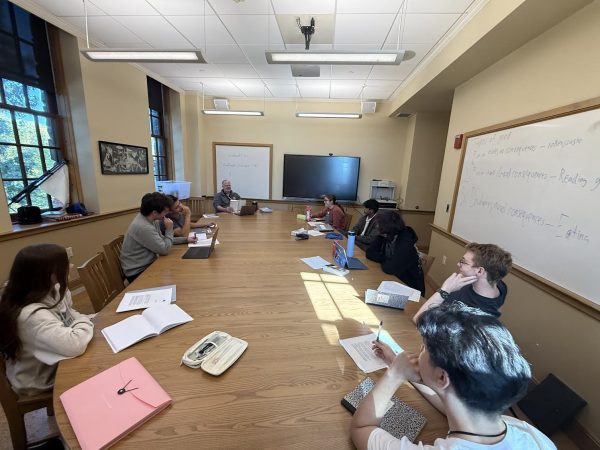False Scare: Hackley Forest Fire Leaves Minimal Damage Yet Threats To Woods Still Remain
Though it may have initially seemed like the Hackley forest fire was one that devastated much of the campus’ wildlife, the negative effects of deer overpopulation and invasive species present a far greater challenge.
Less than a week before the school year started, the Hackley community was alerted of a forest fire that had been discovered earlier that day with unknown origins. While the blaze did not spread far enough to reach any structures on campus, it did manage to burn more or less four acres of the woods.
“It doesn’t look like much when you’re out there. It’s not four square acres, it’s more like fingers of the fire,” biology teacher Tessa Johnson, said.
When thinking of a wildfire, the image that often comes to mind is a massive and destructive one, spanning tens of miles across the forest with clouds of smoke billowing in the air. Though it was most definitely a wildfire, the Hackley forest fire was not nearly as devastating as the ones in California, commonly imagined by most. More surprisingly, the Hackley wildfire should be the least of the community’s concerns when it comes to the current state of the campus woods and its native species.
“There are none [potential implications] just because the deer are such a problem,” Ms. Johnson said, “We’re supposed to have three to four deer per square acre, and we have about 75. So the deer literally eat the entire forest as far as they can reach. If we planted something there, we’d have to fence it off. And a lot of what burned were invasive species anyway. The fire managed to burn some Linen Airwood, which is an invasive viburnum, but we have millions of them in the woods so that’s not that big a deal either.”
According to Teaching Experiments in Ecology, by the end of the 19th century, it was concluded that market industry and subsistence hunting had destroyed deer populations throughout much of the eastern and midwestern regions of the United States. In an attempt to fix the problem, the Supreme Court issued a policy claiming that wild animals were the property of the state. This enables states to regulate licensed hunters to specific seasons, bag limits, and sex restrictions (hunt bucks, spare does, and fawns). The success of this new policy was amplified by the human elimination of natural predators, manipulation of land for agriculture, and private landowners who prohibited hunting on their grounds. Presently, the problem of too few deer has rebounded to one of too many.
The Hackley forest is one of many that struggle to mitigate the amount of deer per square acre with little to no luck. Some forests and counties have attempted to lower deer populations through regulated hunting, live capture, and relocation, or maintained control of reproduction.
In regards to other pressing issues in the woods, Ms. Johnson added, “Our woods are so problematic with other issues, that the wildfire is such a minor thing compared to the deer problem we have. Right now we have Beech Leaf Disease which is killing off the Beech Trees. This is like a drop in the bucket compared to the other problems that the forest is facing.”
Not only did the wildfire have minimal effects on the general environment and invasive species as a whole, but it also “doesn’t really look that different from the rest of the forest out there. Some of the trees have a few burn scars on them and some of the leaves got scorched, like the hickories, but I didn’t see any major tree damage,” said Ms. Johnson. “It took me a while to find it, and I went like two days after the wildfire, and things were still smoking. The smoke was so bad that my clothing smelled like smoke. But that was a month ago, and now you can’t smell the smoke anymore. You can see charred pieces of wood. Right after it happened it did look bad, but now the forest is back to what it was before. It recovered to its status quo, which is not good, but compared to what it was, it recovered pretty quickly.”








